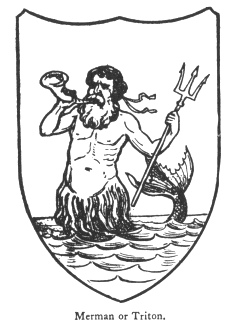
Sacred Texts Legendary Creatures Symbolism Index Previous Next
Buy this Book at Amazon.com


Fictitious and Symbolic Creatures in Art, by John Vinycomb, [1909], at sacred-texts.com
"Triton his trumpet shrill before them blew
For goodly triumph and great jolliment
That made the rocks to roar as they were rent."
Spenser, "Faerie Queen."
(Procession of the Sea Deities.)
Triton was the only son of Neptune and Amphitrite. The poet Apollonius Rhodius describes him as having the upper parts of the body of a man, while the lower parts were those of a dolphin.
[paragraph continues] Later poets and artists revelled in the conception of a whole race of similar tritons, who were regarded
 |
 |
would, as an emblem in heraldry, imply a similar duty or office in the bearer to a great naval hero.
Examples.—The City of Liverpool has for sinister supporter a Triton blowing a conch shell and holding a flag in his right hand.
Lord Lyttelton bears for supporters two Mermen proper, in their exterior hands a trident or.
Ottway, Bart.—Supporters on either side, a Triton blowing his shell proper, navally crowned or, across the shoulder a wreath of red coral, and holding in the exterior hand a trident, point downward.
Note.—In classic story, Triton and the Siren are distinct poetic creations, their vocation and attributes
being altogether at variance—no relationship whatever existing between them. According to modern popular notions, however, the siren or mermaid, and triton, or merman as they sometimes term him, appear to be viewed as male and female of the same creature (in heraldic parlance baron and femme). They thus appear in companionship as supporters to the arms of Viscount Hood, and similarly in other achievements.